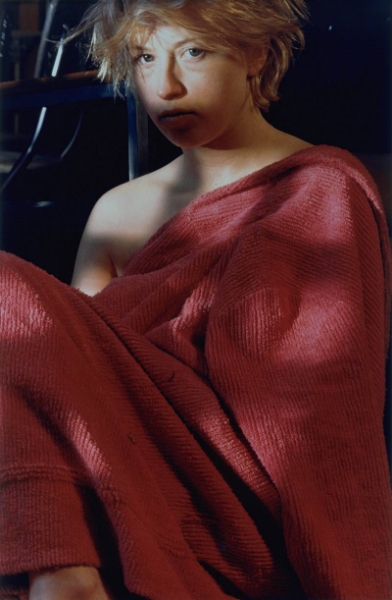Strike a pose: 'Performing for the Camera' at Tate Modern
Romain Mader, Ekaterina: Marriage in Leukerbad, 2012, Photograph, print on aluminium.
‘Don't just stand there, let's get to it. Strike a pose, there's nothing to it'. Madonna, 1990
This phrase perfectly sums up what the latest Tate Modern show ‘Performing for the Camera’ is all about; It revolves around the relation between performance and the all-seeing, all-capturing lens of the camera. The numerous ways in which the two media have interacted with each other are showcased in the exhibit, which presents the audience with works ranging from the early 20th century to our current social media obsessed age.
The show includes examples of the instances where photography was used for the documentation of performances, as well as staging collaborations between photographers and performers - with the end product being a series of photographs. This traditional interaction of the two media has lead artists down experimental avenues between performance and photography, such as photo-specific performances and performative self portraits which examine the notion of identity as social theatre, as well as critiquing current phenomena of our social sphere - all of which are seen in ‘Performing for the Camera’.
With seminal works from art world legends Andy Warhol, Joseff Beuys, Jeff Koons, Yayoi Kusama and Yves Klein curated alongside lesser-known works by fringe performance groups and experimental artists, ‘Performing for the Camera’ sheds light on the myriads of hybrids resulted from the union of performance and photography.
Inspired by the show, here are some works and artists that stood out for me in the exhibit:
David Wojnarowicz, Arthur Rimbaud in New York, 1978-9, gelatin silver print on paper.
In a seemingly effortless manor, artist David Wonjarowicz put on a life-size face mask of the 19th century poet Arthur Rimbaud - an obscene character going down in history for his unapologetic homosexuality - and wondered the streets of New York over the year of 1978-79.
Wojnarowicz revives the queer poet, posing in the streets of a city of decay and entropy, perhaps showing how Rimbaud’s shunning from his peers would one day transform into a self- fulfilling prophecy in the late 70’s New York City - whose artistic and gay communities were about to be plagued by AIDS and gentrification.
Another reading of the work could be that Wojnarowicz’s positioning of the anarchist poet in the streets of New York in broad day light, shows how homosexuality was still considered as a taboo at the time and perhaps that gay individuals did not belong to the mainstream world.
Boris Mikhailov, I Am not I, 1992, Photograph, prints mounted on paper.
Found in the ‘Photographic Actions’ section of the exhibit, the photo-series I Am not I of Ukrainian artist Boris Mikhailov, is an assemblage of provocative self-portraits; The series’s common denominator is Mikhailov’s nude body, posing with satiric props ranging from toy swords to dildos against a D.I.Y. black background.
The informality of the setting, rendered with Mikhailov’s overly theatrical poses and facial expressions, capture the efforts of a man to break free from the depression associated with the later years and collapse of the USSR (Union of Soviet Socialist Republics). A man who rebels against the austerity of his time, choosing to define his identity through silly performative acts, immortalised by the camera.
The small scale photographs are displayed in a format reminiscent of proof sheets and demand the audience’s close attention to reveal Mikhailov’s declaration of personal freedom - which can easily be mistaken as a gesture of mid-life crisis.
Cindy Sherman, Pink Robe - Untitled #98, 1982, Photograph, print on paper.
‘Performing for the camera’ would have been incomplete without featuring some work from the iconic photographer Cindy Sherman - whose work has inspired me from the first day I laid my eyes on it! When I visited the show, not only was I privileged to have finally seen some of her legendary Untitled Film Stills in the flesh, but I was also pleasantly taken aback by her Pink Robe series.
This series of self portraits finds Sherman stripped of the costumes and make up she wore whilst portraying characters in her previous works, sitting on the floor of a naturally lit setting which resembles a domestic room. Wearing nothing more than a pink robe - as the title dictates - Sherman stares the camera right in the eye and creates a channel through which she emotes her feelings via her facial expressions and body movements.
These emotionally charged portraits rely upon the raw force of Sherman’s performance which is preserved through the medium of photography, without which these fleeting moments would elude the viewer’s memories. These moments have become entities which live amongst the art world, confronting the audience with a relatable emotional portrait of a human being.
Cindy Sherman, Pink Robe - Untitled #100, 1982, Photograph, print on paper
Overall, I can say that Performing for the camera has been my personal favourite Tate Modern show, as the subject matter is close to my art practise and my undying efforts to explore the thematics of meta-performance aka the way in which performance diffuses into other media. The show has provided me with an array of artist references I could use to contextualise my work in progress and I would strongly recommend it to anyone who is interested in any form of performance and photography.




